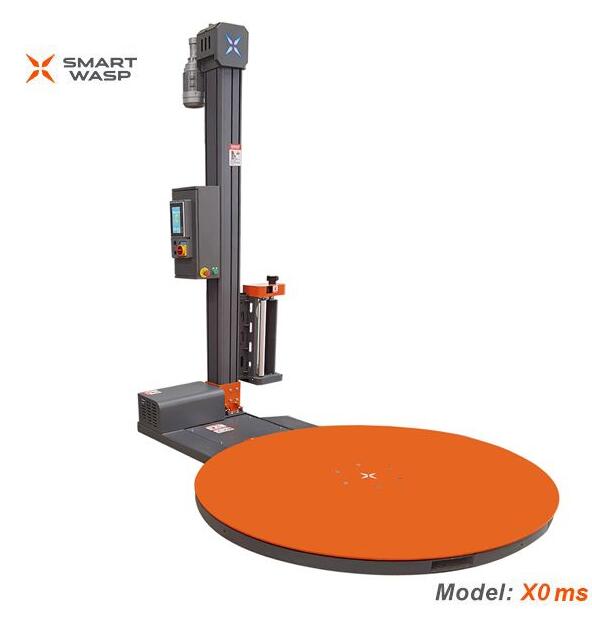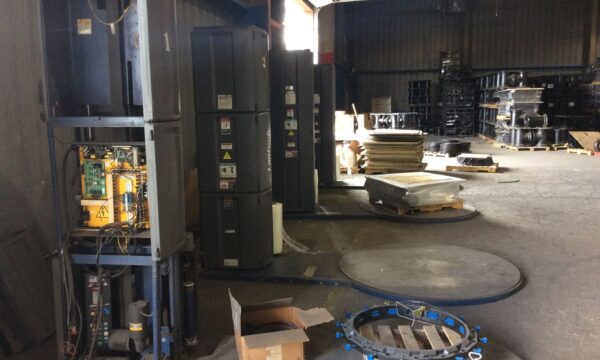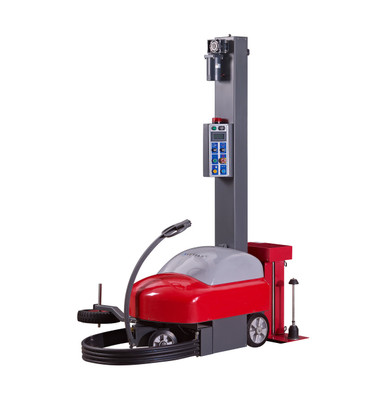Comprehending Typical Concerns in Pallet Wrapping Maker Fixing and Just How to Fix Them
Pallet wrapping makers are integral to effective logistics operations. However, they can experience various problems that interrupt efficiency. Common problems include movie application mistakes, inconsistent tension, and electrical failings. Recognizing these challenges is important for efficient fixing and repair service. By exploring the underlying causes and services, operators can greatly boost machine integrity and decrease downtime. What strategies can be employed to deal with these frequent concerns properly?
Film Application Issues
Movie application issues can substantially affect the efficiency and quality of pallet wrapping procedures. These problems often come from inappropriate alignment of the movie roll, leading to unequal application or extreme slack. Misadjusted tension setups can trigger the movie to be either also loosened or too limited, leading to poor coverage or difficulties in protecting the tons. Furthermore, used or broken rollers may add to inconsistent film feeding, more making complex the application process.
Routine upkeep is necessary to decrease these problems; drivers must regularly evaluate the film course, making certain that all elements are tidy and functioning appropriately. Using the suitable movie type for particular loads can improve performance. Operators needs to also keep an eye on the wrapping rate, as too much speeds might exacerbate application issues. By addressing these factors, performance can be enhanced, ensuring that the pallet covering procedure fulfills both operational standards and quality expectations.
Irregular Stress Issues
Irregular tension in pallet covering makers can greatly impact the quality of the end product. Different variables, such as worn components or inaccurate settings, might add to these tension problems. Recognizing the origin and executing efficient options is essential for keeping excellent performance.
Reasons For Irregular Stress
Preserving appropriate stress throughout the pallet covering procedure is vital for ensuring product stability and load stability. Inconsistent tension can occur from numerous elements. One typical reason is a malfunctioning stress control system, which may fail to use the called for pressure regularly. In addition, variations in the covering products, such as density or elasticity, can cause changes in stress. Mechanical problems, like used rollers or misaligned elements, might additionally add to the problem. Operator error, including improper arrangement or changes, can aggravate stress incongruities. Environmental factors, such as temperature and humidity, may impact the product's characteristics, better complicating tension administration. Recognizing these causes is vital for addressing tension-related issues properly.
Solutions for Stress Troubles
Effective options for addressing tension issues throughout pallet covering can considerably boost lots stability and integrity. To rectify irregular tension issues, operators must initially examine the film roll for defects and assure it is correctly packed. Modifications to the stress settings on the device may likewise be required, as incorrect setups can lead to irregular wrapping. Normal maintenance of the machine's elements, such as the stress arm and brake system, is essential to prevent damage. Furthermore, using high-grade stretch movie created for the certain application can add to even more regular tension. Training employees on proper equipment procedure can minimize user errors that add to stress variations. Implementing these methods can significantly boost pallet wrapping performance.

Mechanical Failings
Mechanical failures in pallet covering machines can interrupt operations and lead to significant downtime. These failings frequently originate from parts such as the film carriage, turntable, or conveyor system. A malfunctioning film carriage can result in improper movie application, endangering load security. Issues with the turntable, such as too much wobbling or failure to turn, can prevent the covering procedure, triggering hold-ups and potential item damage.
Routine upkeep is crucial for avoiding these mechanical concerns. Operators should consistently examine moving components for deterioration, making sure that lubes are applied as needed. Furthermore, appropriate adjustment of tension setups can avoid unnecessary pressure on mechanical parts (pallet wrapping machine repair). In cases where mechanical failings occur, quick troubleshooting ought to be prioritized, concentrating on recognizing the particular malfunctioning component. Replacing worn components promptly can restore the device's performance and minimize functional disruptions
Electrical Breakdowns
Electrical breakdowns in pallet covering makers can result in significant functional disruptions. Usual concerns might include malfunctioning electrical wiring, blown merges, or malfunctioning sensing units, each calling for mindful attention. Comprehending these problems and the needed troubleshooting steps is necessary for reliable repair service and upkeep.
Common Electric Concerns
Many pallet covering check equipments experience common electrical concerns that can disrupt operations. These issues usually consist of blown fuses, damaged electrical wiring, and malfunctioning sensors. A blown fuse can stop the device from powering on, while damaged circuitry might lead to intermittent power loss or short circuits. In addition, sensing units that fail to spot pallet placement can result in incorrect wrapping, causing material waste and prospective damages. An additional constant problem is the malfunction of control panels, which might end up being unresponsive or display screen mistake messages. Recognizing these electric problems is essential for maintaining peak performance and minimizing downtime in pallet covering operations. Routine assessments and maintenance can help determine prospective electrical issues prior to they escalate.
Fixing Actions Explained
Addressing electrical breakdowns in pallet covering equipments requires a methodical strategy to troubleshooting. The initial action involves inspecting power resources, making sure that the device is properly attached and getting electrical power. Next off, drivers must examine for blown integrates or tripped breaker that could disrupt performance. Following this, analyzing wiring for indications of wear or damages is vital, as torn cords can lead to shorts or failures. Evaluating elements such as relays, sensors, and control panels with a multimeter can assist determine faulty parts. Consulting the device's manual can provide specific support for the model in inquiry. By carefully following these steps, specialists can effectively detect and deal with electrical concerns, bring back the device to excellent functioning problem.
Upkeep and Cleaning Obstacles
Pallet wrapping equipments are vital for efficient packaging, they provide distinct maintenance and cleansing obstacles that can hinder functional efficiency. These equipments frequently accumulate dirt, debris, and residues from the wrapping products, which can lead to efficiency issues otherwise resolved regularly. The intricacy of their style can make accessing particular parts for extensive cleansing challenging, complicating routine maintenance.
The use of various movies and adhesives can result in deposit buildup on rollers and various other relocating components, possibly causing rubbing and wear. Operators may struggle to locate suitable cleansing solutions that do not harm sensitive parts or influence the machine's functionality. Additionally, the requirement for routine lubrication and part assessments includes to the maintenance problem. Developing a thorough cleaning procedure tailored to the certain device design is vital for making certain and stopping costly repair services durability, eventually maintaining production effectiveness.

Fixing Strategies for Quick Resolution
Reliable fixing methods are vital for keeping the operational efficiency of pallet covering makers. When problems occur, the initial action is to carry out a visual inspection to determine any kind of noticeable issues, such as imbalances or damaged parts. Following this, operators should speak with the maker's guidebook for details error codes and recommended remedies. Utilizing diagnostic devices can better help in determining malfunctions.
Another crucial method involves methodically examining private elements, such as the film dispenser and tension controls, to isolate the source of the problem. Maintaining a log of past concerns and resolutions can additionally streamline future troubleshooting efforts. In addition, educating staff on usual issues and their repairs boosts total action time. By executing these techniques, operators can quickly solve problems, lessening downtime and ensuring constant efficiency within their procedures.
Often Asked Questions
Exactly how Typically Should I Replace the Film in My Pallet Wrapping Equipment?
The movie in a pallet covering machine must be changed frequently, commonly every couple of hours of operation, depending upon usage. Frequent inspections assure peak efficiency and protect against damage to items during the covering procedure.
What Sorts of Movie Are Ideal for Pallet Wrapping Machines?
Polyethylene and stretch movies are best for pallet wrapping makers, supplying exceptional load stability and defense (pallet wrapping machine repair). High-performance alternatives, such as helpful hints pre-stretched films, enhance efficiency and reduce product use, making them a preferred selection for many drivers
Can Temperature Level Influence the Efficiency of the Covering Machine?
Temperature can substantially impact the performance of wrapping devices. Severe heat might create materials to come to be as well flexible, while cold problems can bring about brittleness, eventually impacting the quality and efficiency of the wrapping procedure.
Exactly how Do I Pick the Right Pallet Covering Machine for My Requirements?
Picking the ideal pallet wrapping equipment includes reviewing item measurements, weight, quantity, and specific product packaging needs. Reviewing equipment speed, ease of use, and upkeep requirements is also vital for ideal effectiveness and cost-effectiveness in procedures.
What Safety Precautions Should I Take During Repair works?
Throughout fixings, one should always detach power, wear safety gear, guarantee proper ventilation, and follow maker standards. Additionally, maintaining a tidy work area and making use of the right tools boosts security and effectiveness throughout the repair work process.
